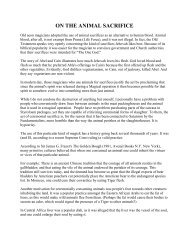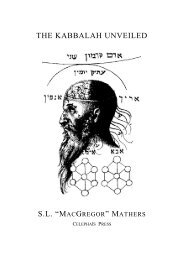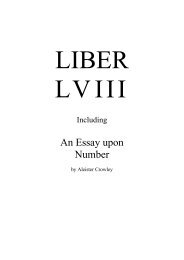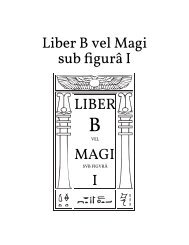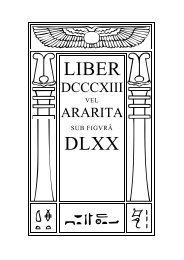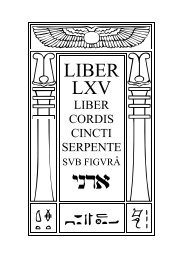Annotated Ritual of the Eucharist
Annotated Ritual of the Eucharist
Annotated Ritual of the Eucharist
Create successful ePaper yourself
Turn your PDF publications into a flip-book with our unique Google optimized e-Paper software.
The PRIEST parts <strong>the</strong> veil with his lance. (During <strong>the</strong> previous speeches<br />
<strong>the</strong> PRIESTESS has, if necessary, as in savage countries, resumed her<br />
robe.) 69<br />
The PRIEST: IΩ ΙΩ ΙΩ ΙΑΩ ΣΑΒΑΟ. ΚΥΡΙΕ ΑΒΡΑΣΑΞ ΚΥΡΙΕ ΜΕΙΘΡΑΣ ΚΥΡΙΕ<br />
ΦΑΛΛΕ. ΙΩ ΠΑΝ, ΙΩ ΠΑΝ ΠΑΝ ΙΩ ΙΣΧΥΡΟΣ, ΙΩ ΑΤΗΑΝΑΤΟΣ ΙΩ<br />
ΑΒΡΟΤΟΣ ΙΩ ΙΑΩ. ΧΑΙΡΕ ΦΑΛΛΕ ΧΑΙΡΕ ΠΑΜΦΑΓΕ ΧΑΙΡΕ<br />
ΠΑΓΓΕΝΕΤΟΡ. ΑΓΙΟΣ, ΑΓΙΟΣ, ΑΓΙΟΣ ΙΑΩ. 70<br />
The PRIESTESS is seated with <strong>the</strong> Paten in her right hand and <strong>the</strong> cup<br />
in her left.<br />
The PRIEST presents <strong>the</strong> Lance, which she kisses eleven times. 71<br />
She <strong>the</strong>n holds it to her breast, 72 while <strong>the</strong> PRIEST, falling at her knees,<br />
kisses <strong>the</strong>m, his arms stretched along her thighs. 73 He remains in<br />
this adoration while <strong>the</strong> DEACON intones <strong>the</strong> Collects. 74<br />
All stand to order. 75<br />
69 “It only takes one savage among <strong>the</strong> People to make a ‘savage country,’ and <strong>the</strong> power to assess <strong>the</strong> degree <strong>of</strong><br />
‘savagery’ in <strong>the</strong> temple properly belongs solely to <strong>the</strong> Priestess. Some circumstances may require that <strong>the</strong><br />
Priestess resume her robe, but nobody has <strong>the</strong> right to insist to her that she leave it <strong>of</strong>f.” –Helena & T Apiryon<br />
70 By its position, after <strong>the</strong> recital <strong>of</strong> scripture and <strong>the</strong> invocation <strong>of</strong> <strong>the</strong> “trinity” (<strong>of</strong> CCXX), and before <strong>the</strong><br />
sanctus, this invocation seems to correspond to <strong>the</strong> Preface in <strong>the</strong> Roman Mass. The two most common texts<br />
for <strong>the</strong> Preface are <strong>the</strong> Common Preface and <strong>the</strong> Preface for <strong>the</strong> Holy Trinity. Both invoke <strong>the</strong> celestial<br />
hierarchy (Common: Angels, Dominations, Powers, Virtues, Seraphim; Trinity: Angels, Archangels, Cherubim,<br />
Seraphim). Both culminate with <strong>the</strong> Seraphim, who are flaming serpents--quite explicitly identified with phallic<br />
mysteries by Blavatsky in The Secret Doctrine. During <strong>the</strong> final “ΑΓΙΟΣ, ΑΓΙΟΣ, ΑΓΙΟΣ ΙΑΩ” <strong>the</strong> Priest may<br />
raise <strong>the</strong> Lance. (C.f. <strong>the</strong> elevation <strong>of</strong> <strong>the</strong> Host at <strong>the</strong> end <strong>of</strong> section VI.)<br />
71 See note 40.<br />
72 The Priestess will need to set down <strong>the</strong> cup and paten, in order to hold <strong>the</strong> Lance to her breast.<br />
73 During <strong>the</strong> Collects, <strong>the</strong> Priest remains entirely focused on his adoration at <strong>the</strong> knees <strong>of</strong> <strong>the</strong> Priestess. The<br />
kisses are essential to <strong>the</strong> “adoration” in which he “remains.” His attention is so devoted that he is aware <strong>of</strong><br />
nothing o<strong>the</strong>r than <strong>the</strong> contact between his lips and her knees, and that binary kissing/not-kissing alternation<br />
becomes his sole perception and expression. In this ecstasy, he becomes a magick engine providing power to<br />
<strong>the</strong> Collects, which are directed by <strong>the</strong> Deacon, and assisted by <strong>the</strong> Priestess and <strong>the</strong> People.<br />
74 “We are fortunate enough to have a recording <strong>of</strong> Crowley reciting <strong>the</strong> first few Collects. While he uses a<br />
musical phrase for ‘So mote it be,’ he does not chant <strong>the</strong> text <strong>of</strong> <strong>the</strong> Collects. He does recite <strong>the</strong>m, in a<br />
sonorous, well-supported speaking voice, and this, I would note again, is also a meaning <strong>of</strong> <strong>the</strong> verb ‘to intone.’<br />
... If <strong>the</strong> Deacon prefers to chant or sing <strong>the</strong> Collects, let’s avoid <strong>the</strong> all-<strong>the</strong>-words-on-a-monotone-until-<strong>the</strong>last-sylla-buuuulllll,<br />
with that drop at <strong>the</strong> end. This style not only obscures <strong>the</strong> text <strong>of</strong> <strong>the</strong> Collects, it<br />
disconnects <strong>the</strong> meaning and beauty <strong>of</strong> that text in what should be an intimate moment shared by <strong>the</strong> Deacon<br />
and <strong>the</strong> People. It does not exalt <strong>the</strong> participants, it numbs <strong>the</strong>m.” –Br. Paul Hume<br />
75 See note 48. The rubrics in this ritual for seating and standing <strong>of</strong> <strong>the</strong> people are notoriously difficult. Most<br />
congregations are in <strong>the</strong> habit <strong>of</strong> seating <strong>the</strong> people at <strong>the</strong> beginning <strong>of</strong> section V, and this practice is entirely<br />
acceptable. It provides for a dramatic contrast when “All stand, Head erect, Eyes open” for <strong>the</strong> final two<br />
Collects. T Apiryon notes that <strong>the</strong> latter rubric was not added to <strong>the</strong> ritual until 1929/30 in <strong>the</strong> appendices <strong>of</strong><br />
Magick in Theory & Practice. In a description <strong>of</strong> something very much like a Gnostic Mass in Diary <strong>of</strong> a Drug Fiend,<br />
Crowley writes <strong>of</strong> <strong>the</strong> behavior <strong>of</strong> <strong>the</strong> congregation during <strong>the</strong> Death Collect: “. . . all rose to <strong>the</strong>ir feet and<br />
addressed Death . . . The gesture <strong>of</strong> standing to meet Death was nobly impressive.” (pp. 360-1) And yet, in a<br />
conversation circa 1995 e.v., Patriarch Hymenaeus Beta expressed his opinion (at that time) that <strong>the</strong> people<br />
Liber XV with Practical Annotations by T Polyphilus, Ep. Gn. 13



